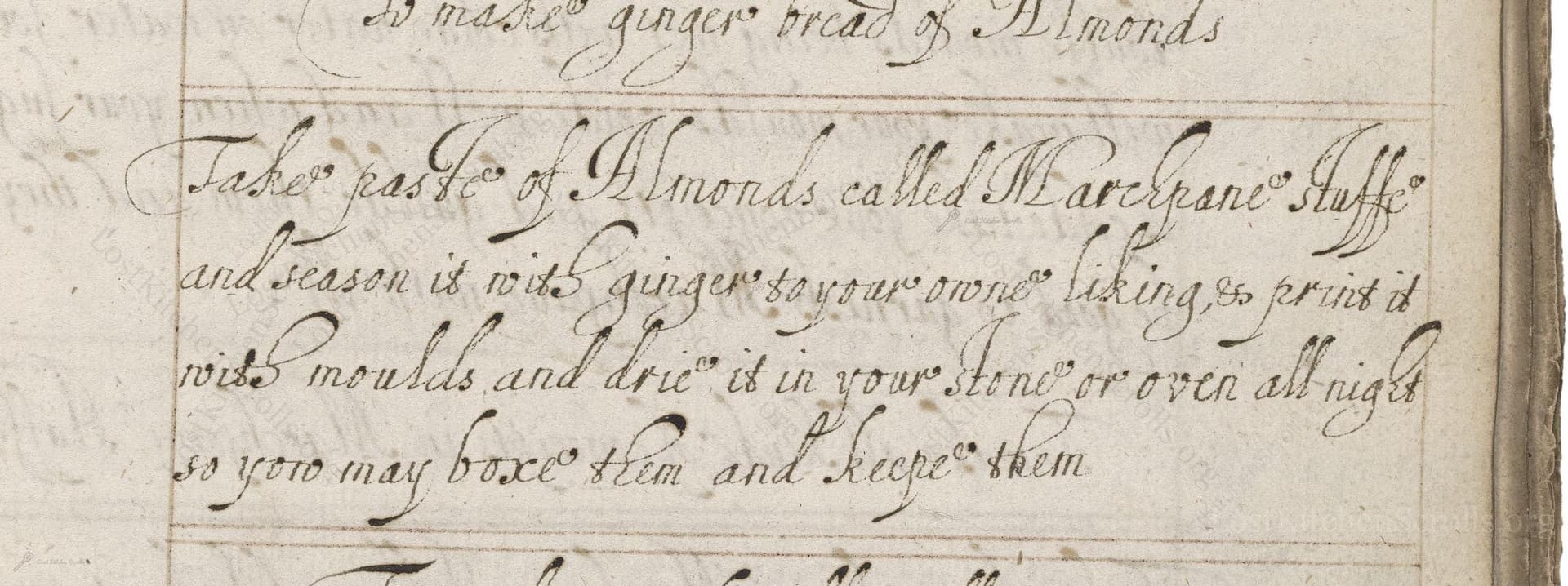To Make Ginger Bread Of Almonds
From the treasured pages of Medicinal and cookery recipes by John King
Written by John King

To Make Ginger Bread Of Almonds
"Take paste of Almonds called Marchpane stuffe and season it with ginger to your owne liking, & print it with moulds and drie it in your stove or oven all night so you may boxe them and keepe them"
Note on the Original Text
This recipe is typical of early modern English cookery writing—short, imprecise, and assuming a skilled reader. Measurements are to the cook's discretion ('to your own liking'), and instructions rely on shared culinary knowledge. The spelling ('Marchpane stuffe', 'boxe them') reflects the transitional nature of 17th-century English, and words like 'print' mean to press into a mould rather than modern-day actual printing. The process is as much about preserving as it is about flavor.

Title
Medicinal and cookery recipes by John King (1675)
You can also click the book image above to peruse the original tome
Writer
John King
Era
1675
Publisher
Unknown
Background
A delightful journey into the kitchens of the 17th and early 18th centuries, this collection, attributed to John King, brims with time-honored recipes, culinary wisdom, and flavors that once graced historic tables.
Kindly made available by
Folger Shakespeare Library
This recipe comes from the early modern English manuscript tradition, roughly dated to between 1625 and 1725. Recorded under the authorship of John King, it reflects the fashionable use of almonds and spices like ginger in elite English households. 'Marchpane'—the predecessor to modern marzipan—was a luxurious sweet and often intricately moulded for display at banquets. Ginger, newly imported and prized for its warmth and piquancy, was a favorite addition to sweets in this era, marrying the exotic with the locally produced almonds. Recipes like this showcase the transition from medieval spice blends toward more focused flavor combinations.

In the 17th century, cooks would have used a large mortar and pestle to grind almonds into a paste, and wooden boards for kneading. Ornate gingerbread moulds, often carved with symbolic patterns, gave these treats their distinctive look. Drying was done in the residual heat of a wood-fired bread oven or in a purpose-built 'stove', a kind of early hot cupboard for gentle heat.
Prep Time
15 mins
Cook Time
8 hrs
Servings
12
We've done our best to adapt this historical recipe for modern kitchens, but some details may still need refinement. We warmly welcome feedback from fellow cooks and culinary historians — your insights support the entire community!
Ingredients
- 7 oz blanched almonds (or ready-made almond meal/marzipan as substitute)
- 5.3 oz icing sugar
- 1-2 tsp ground ginger
- A few drops rosewater (substitute: water or orange blossom water)
Instructions
- Begin by making a simple almond paste by blending 7 oz of blanched almonds with 5.3 oz of icing sugar and a few drops of rosewater for moisture, forming a smooth, pliable dough known today as marzipan.
- Season this almond paste with 1-2 teaspoons of ground ginger, adjusting to your taste.
- Roll the dough to about 3/8 inch thickness, then press it into decorative moulds or shape it by hand into small rounds or bars.
- Place the shaped pieces on baking paper and allow them to dry in a very low oven (around 160°F, or as low as your oven allows) overnight, or until completely dry and firm.
- Once cooled, store them in an airtight container.
Estimated Calories
90 per serving
Cooking Estimates
You will need about 15 minutes to make the almond paste, mix in the ginger, and shape the pieces. The drying in the oven will take about 8 hours. Each piece is about 90 calories if you make 12 small pieces from this recipe.
As noted above, we have made our best effort to translate and adapt this historical recipe for modern kitchens, taking into account ingredients nowadays, cooking techniques, measurements, and so on. However, historical recipes often contain assumptions that require interpretation.
We'd love for anyone to help improve these adaptations. Community contributions are highly welcome. If you have suggestions, corrections, or cooking tips based on your experience with this recipe, please share them below.
Join the Discussion
Rate This Recipe
Dietary Preference
Main Ingredients

Den Bockfisch In Einer Fleisch Suppen Zu Kochen
This recipe hails from a German manuscript cookbook compiled in 1696, a time whe...

Die Grieß Nudlen Zumachen
This recipe comes from a rather mysterious manuscript cookbook, penned anonymous...

Ein Boudain
This recipe comes from an anonymous German-language manuscript cookbook from 169...

Ein Gesaltzen Citroni
This recipe, dating from 1696, comes from an extensive anonymous German cookbook...
Browse our complete collection of time-honored recipes



